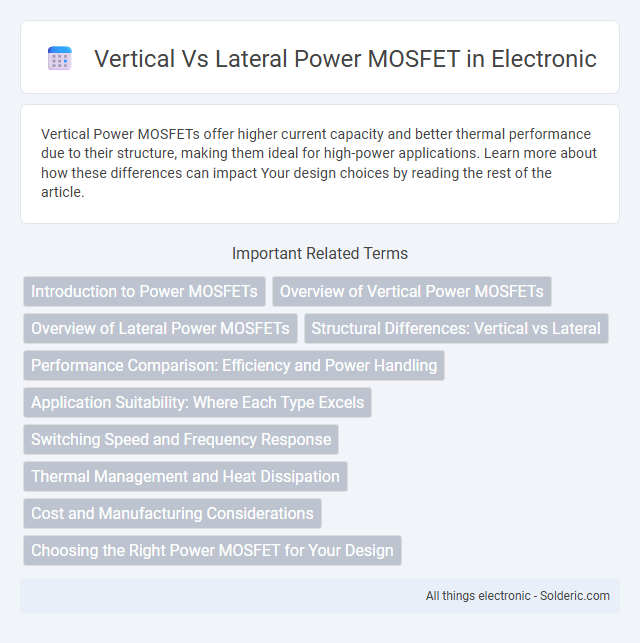Vertical Power MOSFETs offer higher current capacity and better thermal performance due to their structure, making them ideal for high-power applications. Learn more about how these differences can impact Your design choices by reading the rest of the article.
Comparison Table
| Feature | Vertical Power MOSFET | Lateral Power MOSFET |
|---|---|---|
| Current Flow | Vertical (from top to bottom) | Lateral (parallel to the surface) |
| Voltage Rating | High voltage capability (up to kV range) | Lower voltage, typically under 100V |
| On-Resistance (R_DS(on)) | Lower due to vertical conduction path | Higher, limited by planar structure |
| Switching Speed | High-speed switching possible | Moderate switching speed |
| Power Handling | Supports high power applications | Suited for low to medium power |
| Manufacturing Process | Complex, requires vertical structuring | Simpler planar fabrication |
| Application | Power supplies, motor drives, high-power circuits | Analog circuits, RF switches, low-voltage applications |
Introduction to Power MOSFETs
Power MOSFETs are semiconductor devices designed to handle high voltage and current, critical in power electronics applications. Vertical MOSFETs feature current flow from the top to the bottom of the chip, offering low on-resistance and high voltage capabilities, making them ideal for power conversion. Lateral MOSFETs conduct current parallel to the chip surface, generally providing faster switching speeds and better integration in ICs, which benefits your circuit design depending on the application requirements.
Overview of Vertical Power MOSFETs
Vertical Power MOSFETs feature a structure where the current flows vertically from the drain to the source, allowing for higher current capacity and better heat dissipation compared to lateral MOSFETs. These devices are commonly used in high-power applications such as power supplies, motor control, and automotive systems due to their low on-resistance and high efficiency. Optimizing your circuit with vertical MOSFETs can improve performance by handling larger currents and reducing thermal stress.
Overview of Lateral Power MOSFETs
Lateral Power MOSFETs are semiconductor devices where current flows parallel to the surface of the silicon die, making them ideal for high-frequency and low-voltage applications. These MOSFETs offer advantages in integration with CMOS processes, allowing efficient control circuits on the same chip for compact power management solutions. Understanding the structure and operation of lateral Power MOSFETs can help optimize Your device design for switching performance and thermal management.
Structural Differences: Vertical vs Lateral
Vertical Power MOSFETs feature a layered structure where current flows vertically from the source at the top to the drain at the bottom through a heavily doped substrate, enabling higher voltage withstand capability and lower on-resistance. Lateral Power MOSFETs have current flow parallel to the semiconductor surface, with the source and drain placed side-by-side on the same plane, making them suitable for low voltage applications and integration in CMOS processes. The key structural difference lies in the current flow direction and device layout, influencing their electrical performance and application scope.
Performance Comparison: Efficiency and Power Handling
Vertical Power MOSFETs exhibit higher power handling capabilities due to their robust vertical current flow path, enabling lower on-resistance and enhanced thermal dissipation. Lateral Power MOSFETs typically offer faster switching speeds but with increased conduction losses, limiting efficiency in high-power applications. Efficiency in vertical types surpasses lateral designs at higher voltages and currents, making them ideal for power-intensive environments.
Application Suitability: Where Each Type Excels
Vertical Power MOSFETs excel in high-current and high-power applications such as power supplies, motor drives, and automotive systems due to superior on-resistance and thermal performance. Lateral Power MOSFETs are better suited for low-voltage, high-frequency switching in integrated circuits and RF amplifiers, offering easier integration with signal processing components. Your choice depends on the specific application requirements for current capacity, switching speed, and integration complexity.
Switching Speed and Frequency Response
Vertical Power MOSFETs exhibit superior switching speed and frequency response due to their low on-resistance and reduced gate charge, enabling efficient operation in high-frequency applications. Lateral Power MOSFETs generally have higher parasitic capacitances, limiting their switching speed and frequency capabilities compared to vertical structures. Choosing the right MOSFET for your application ensures optimal performance, especially when high switching frequency and fast transient response are critical.
Thermal Management and Heat Dissipation
Vertical Power MOSFETs generally offer superior thermal management and heat dissipation due to their structure, which allows heat to flow directly through the silicon substrate to the mounting surface, minimizing thermal resistance. Lateral Power MOSFETs, however, dissipate heat across the chip surface, resulting in higher thermal resistance and potentially less efficient cooling. For your applications demanding robust thermal performance, vertical MOSFETs are often the optimal choice to maintain device reliability and efficiency under high power conditions.
Cost and Manufacturing Considerations
Vertical power MOSFETs generally offer lower manufacturing costs due to simpler wafer processing and higher current handling capabilities, enabling cost-efficient production at scale. Lateral power MOSFETs involve more complex fabrication steps with additional isolation and planar structures, resulting in higher production expenses. The vertical architecture's superior thermal management also reduces packaging costs, contributing to overall economic advantages in high-voltage applications.
Choosing the Right Power MOSFET for Your Design
Choosing the right power MOSFET depends on your design's voltage, current, and switching speed requirements. Vertical MOSFETs offer lower on-resistance and higher current capacity, making them ideal for high-power applications, while lateral MOSFETs provide better high-frequency performance and simpler integration for low-voltage circuits. Understanding these differences ensures optimal efficiency and reliability in your electronic system.
Vertical vs Lateral Power MOSFET Infographic

 solderic.com
solderic.com